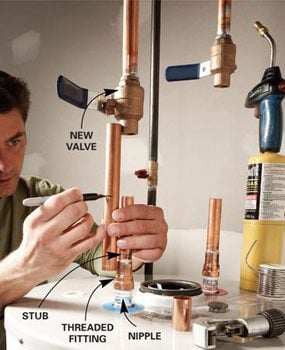If you have a water heater in your home, it’s important to keep it in good working order. One way to do this is to install dielectric nipples on the water heater. Dielectric nipples are devices that help to prevent corrosion on the water heater.
Corrosion can cause the water heater to break down and stop working. The dielectric nipple helps to protect the water heater from corrosion by providing a barrier between the water and the metal of the water heater. Dielectric nipples are easy to install and can be found at most hardware stores.
If you have a water heater, then you know that there are a lot of different parts that go into making it work correctly. One of these parts is the dielectric nipple. This is a small part, but it plays a big role in ensuring that your water heater works correctly.
Here are a few tips on installing dielectric nipples on your water heater.
1. First, you will need to turn off the power to your water heater. This can be done by flipping the breaker switch in your main breaker box.
2. Next, you will need to locate the dielectric nipples on your water heater. These are typically located near the top of the water heater.
3. Once you have located the dielectric nipples, you will need to remove the old ones.
To do this, simply unscrew them from their location.
Water Heater Dielectric Union Replacement
Do you need dielectric nipples on water heater?
There is a lot of confusion out there about dielectric nipples and whether or not they are required on water heaters. The answer is that it depends on the situation. If you have a metal water pipe that is in contact with the metal water heater tank, then a dielectric nipple is required.
This is because the metal water pipe will corrode the tank if they are in contact. The dielectric nipple prevents this by creating a barrier between the two metals.
If you have a plastic water pipe that is not in contact with the metal water heater tank, then a dielectric nipple is not required.
This is because plastic does not corrode metal.
The bottom line is that if you have a metal water pipe that is in contact with the metal water heater tank, then you need a dielectric nipple.
How do you install a dielectric union on a water heater?
Installing a dielectric union on a water heater is a simple process that can be completed in a few minutes with the proper tools. The first step is to shut off the power to the water heater. Next, locate the two copper pipes that run to the water heater.
These pipes will be connected to the dielectric union.
Using a wrench, loosen the nuts that secure the pipes to the water heater. Be careful not to damage the pipes or the threads on the water heater.
Once the nuts are loose, remove the pipes from the water heater.
Now, take the dielectric union and place it over the two pipes. Make sure that the union is aligned so that the holes for the pipes line up.
Once the union is in place, thread the nuts back onto the pipes.
Tighten the nuts with the wrench, being careful not to overtighten. Finally, turn the power back on to the water heater.
How do you install dielectric heat trap nipples?
Dielectric heat trap nipples are installed by first removing the old nipple and then cleaning the threads on the dielectric heat trap nipple and the corresponding threads on the water heater. Next, apply pipe joint compound to the threads on the dielectric heat trap nipple. Finally, screw the dielectric heat trap nipple into the water heater and hand-tighten until snug.
See also: Installing Drip Pan Under Water Heater
Do you need dielectric fittings on a water heater?
While dielectric fittings are not required on a water heater, they may be used in certain circumstances to prevent galvanic corrosion. Galvanic corrosion occurs when two dissimilar metals are in contact with each other in the presence of an electrolyte, such as water. When this happens, electrons flow from the more active metal to the less active metal, causing the less active metal to corrode.
Dielectric fittings are used to isolate dissimilar metals from each other, preventing galvanic corrosion from occurring. In most cases, dielectric fittings are only necessary when there is a risk of galvanic corrosion, such as when two different metals are in contact with each other in an moist or wet environment. However, dielectric fittings may also be used for other purposes, such as to isolate two dissimilar metals that are in close proximity to each other.

Credit: www.familyhandyman.com
Water heater dielectric nipples
Dielectric nipples are used to connect two copper pipes together while preventing electrical current from flowing between them. This is important because it prevents the pipes from corroding. Dielectric nipples are made of a material that is electrically insulating, such as plastic or rubber.
They are available in different sizes to fit different pipe diameters.
Rheem water heater dielectric nipples
Rheem water heater dielectric nipples are an important part of the water heater. They are used to connect the water heater to the electrical system. Dielectric nipples are made of a material that is resistant to electricity.
This helps to prevent electrical shocks.
Do rheem water heaters have dielectric nipples
If you’re in the market for a new water heater, you may be wondering if Rheem water heaters have dielectric nipples. The answer is yes! Rheem water heaters are equipped with dielectric nipples, which are designed to prevent corrosion and extend the life of your water heater.
Dielectric nipples are made of a non-conductive material, which helps to prevent corrosion by creating a barrier between dissimilar metals. This is especially important in water heaters, where the tank is made of steel and the heating elements are made of copper. Without a dielectric nipple, the two metals would come into contact and corrode over time.
Dielectric nipples also help to extend the life of your water heater by preventing sediment buildup. Sediment can build up on the heating elements and eventually cause them to fail. By preventing sediment buildup, dielectric nipples help keep your water heater running smoothly for years to come.
Conclusion
If your home has a water heater, chances are it has dielectric nipples. Dielectric nipples are installed on water heaters to help prevent corrosion. Over time, corrosion can build up on the water heater tank and cause it to fail.
Dielectric nipples are made of a material that is resistant to corrosion, so they can help extend the life of your water heater.
To install dielectric nipples, you will need to shut off the power to the water heater and drain the tank. Once the tank is empty, remove the old nipples and install the new ones.
Be sure to use Teflon tape or pipe sealant on the threads to prevent leaks. Once the new nipples are in place, you can refill the tank and turn the power back on.
You Can Also Read:

